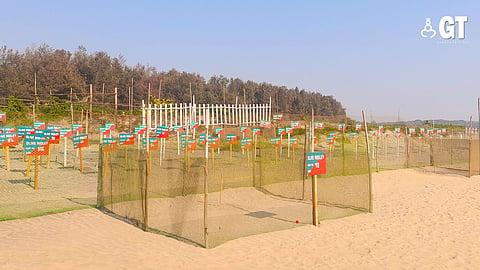

With a turtle laying its eggs in Vagator during the night of March 4, 2024, North Goa recorded its 145th turtle nesting of season 2023-24 recording a twofold jump compared to last season.
“This is a family effort. From 69 nesting’s last year, we are at 145 and still going and till date we have had 607 hatchlings from seven nests that had a total of 734 eggs,” disclosed a jubilant Rajan Harlankar.
With an increase in the number of turtles coming to nest on the northern coastal belt from Candolim to Pernem, the Forest Department added two more staffers to its turtle protection team taking the total strength to ten with most patrolling the beaches at night.
“Most turtles come ashore to lay their eggs at night and hatchlings start creeping out at night. We collect them in a container and release them on shore just before the water breaks,” explained Trivrikram Morje who was next to follow in the steps of Harlankar.
Amol Parab, Pratik Shetye, Krishna Hule, Dyneshwar Thakar, Avelino D’Silva, Pandurang Harlankar and Kalidas Gaonkar are the other members of the team that keep a vigil on the space where turtles nest in the north.
The first turtle came ashore to lay eggs on December 27, 2023 and the first hatchlings were released into the sea on February 16. “The first turtle laid 92 eggs and we got 63 hatchlings (68%),” disclosed Morje.
The 145th nesting, according to Morje, “was located to the right of the cross, away from the rocks on Vagator beach.” This has buoyed the villagers who plan to get it declared as a turtle nesting site .
“I will be going to the wild Life division of the Forest Department to demand that Dream Beach be declared a turtle nesting site,” declared Michael from Vagator.
“Dream Beach in Vagator is known for hosting rave parties till early morning, despite a Supreme Court order to the contrary and we are happy that since a nesting has been officially recorded, the Forest Department will act,” said an optimistic Michael.
The High Court of Bombay at Goa had come down on beach parties being held close to turtle nesting sites and had called for an inquiry into the effects of such parties.
“These are highly vulnerable locations because there are very few places around the globe where such sites remain. Literature suggests that the Olive Ridley Turtles have been coming to these few and chosen sites for thousands of years for nesting. Therefore, it would not be an exaggeration to state that these are natural heritage sites, if not natural wonders,” Justice M S Sonak and Justice B P Deshpande of the High Court bench were reported to have said.
The 7th nesting was the most productive with 97 hatchlings from 102 eggs – 95 per cent. The lowest percentage was recorded from the 5th nesting which saw 68 hatchlings from 109 eggs.